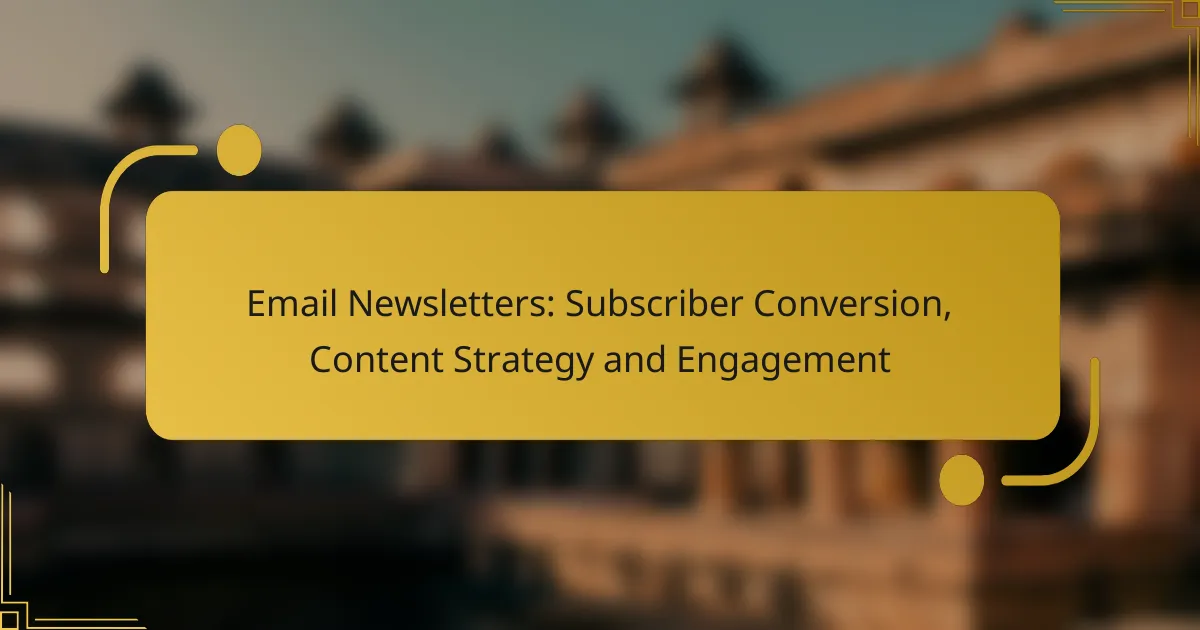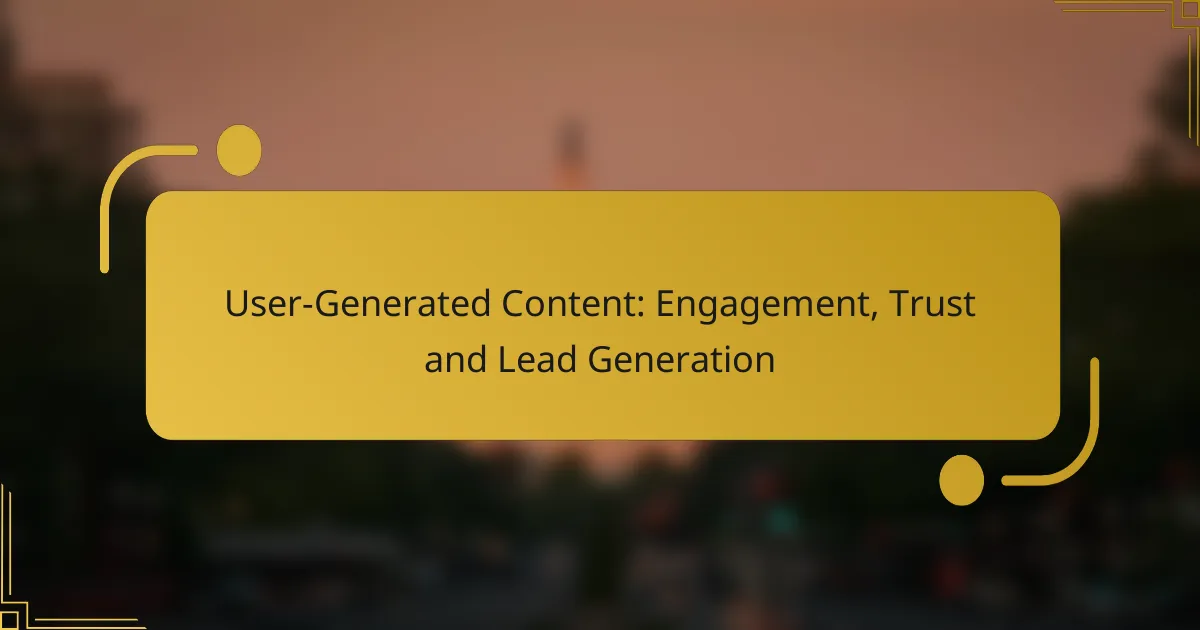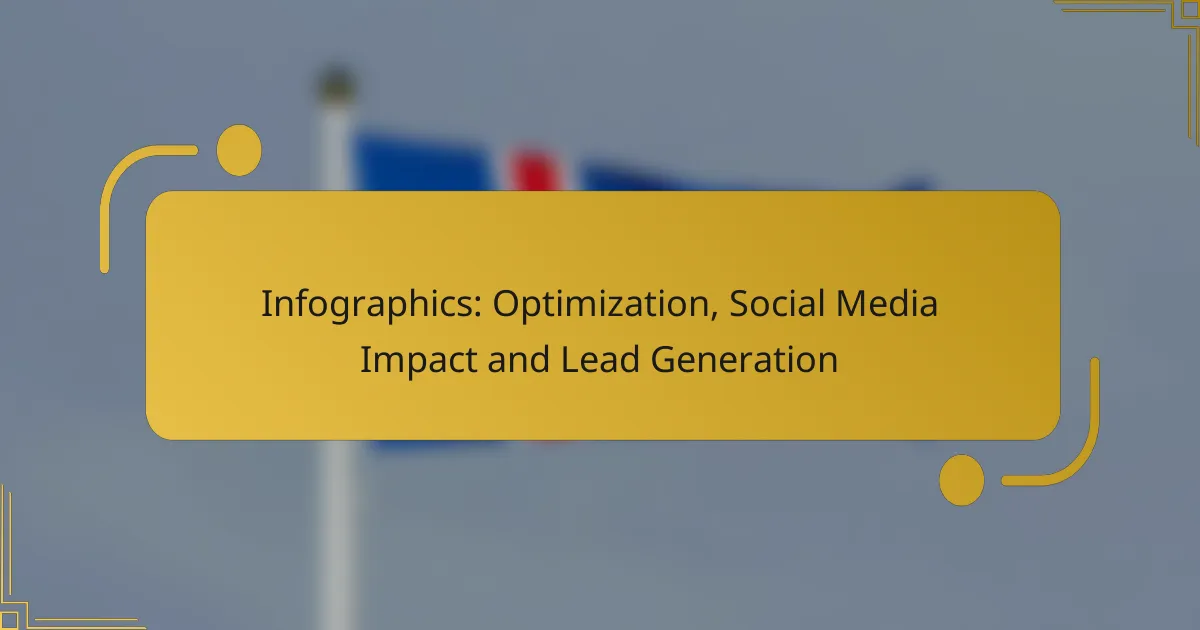Email newsletters are a powerful tool for engaging audiences and converting subscribers. By crafting compelling value propositions and optimizing user experiences, businesses can enhance subscription rates and foster deeper connections. A well-defined content strategy that prioritizes relevance and personalization is key to maintaining subscriber interest and driving engagement.
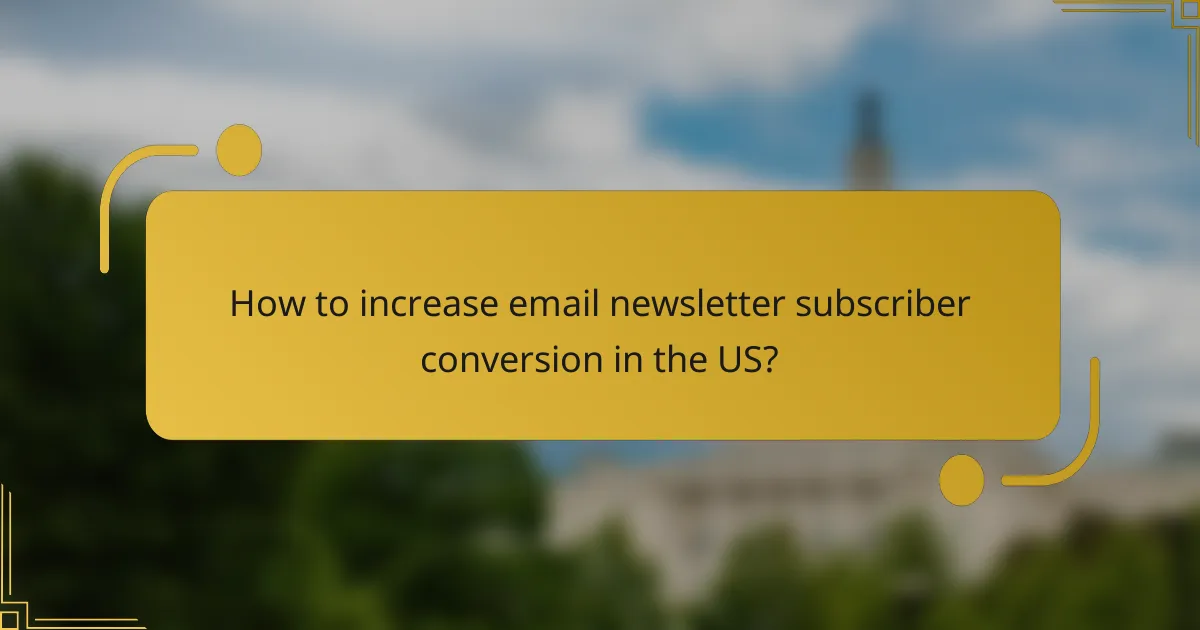
How to increase email newsletter subscriber conversion in the US?
To increase email newsletter subscriber conversion in the US, focus on creating compelling value propositions and optimizing user experiences. By implementing effective strategies, you can significantly boost your subscription rates and engage your audience more effectively.
Optimize landing pages
Optimizing landing pages is crucial for converting visitors into subscribers. Ensure that your landing page has a clear and concise message, highlighting the benefits of subscribing. Use strong calls to action (CTAs) that encourage immediate sign-ups.
Consider A/B testing different layouts, colors, and text to see what resonates best with your audience. A well-designed landing page can increase conversion rates by a significant margin, often in the range of 20-30%.
Utilize social proof
Social proof can enhance credibility and encourage potential subscribers to join your newsletter. Display testimonials, subscriber counts, or endorsements from reputable sources to build trust. Highlighting that others find value in your content can motivate new subscribers.
For example, showcasing that thousands of users are already subscribed can create a sense of community and urgency. Incorporate social proof strategically on your landing pages and promotional materials.
Offer exclusive content
Offering exclusive content is an effective way to entice visitors to subscribe to your newsletter. Consider providing unique resources such as e-books, whitepapers, or access to premium articles that are only available to subscribers.
Make it clear what subscribers will gain by signing up. For instance, you could promise weekly insights, exclusive discounts, or early access to new products. This added value can significantly increase conversion rates.
Implement exit-intent popups
Exit-intent popups can capture potential subscribers who are about to leave your site. These popups detect user behavior and trigger a message offering an incentive to subscribe, such as a discount or free resource.
Ensure that your popups are not intrusive and provide a clear benefit. A well-timed exit-intent popup can recover a portion of abandoning visitors, often converting 5-10% of them into subscribers.
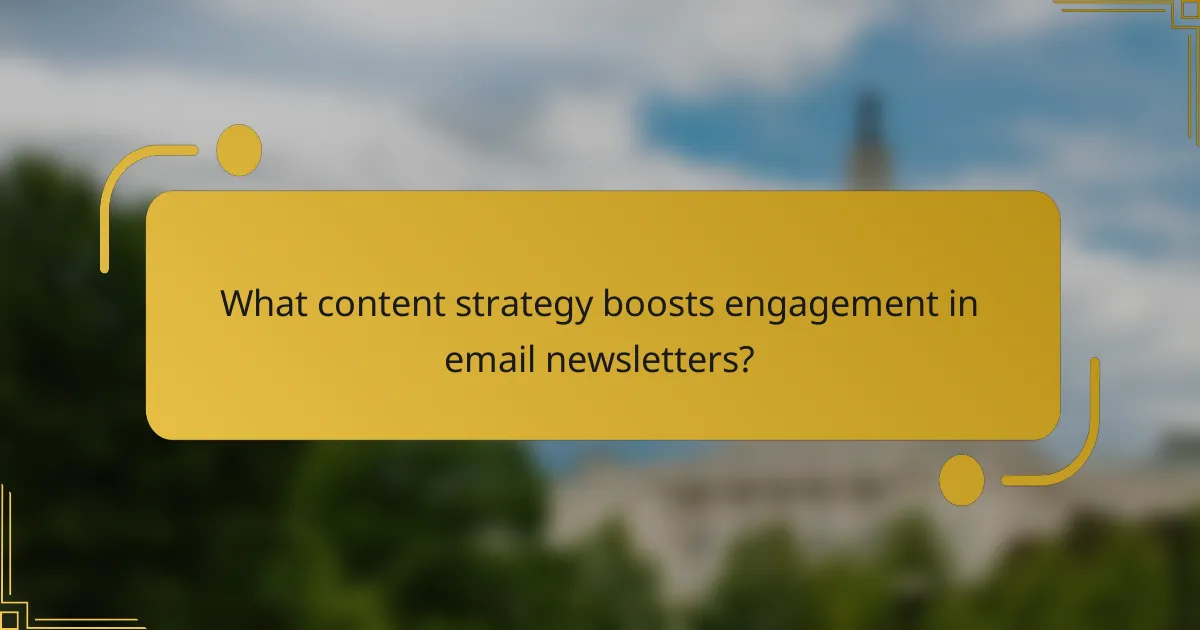
What content strategy boosts engagement in email newsletters?
A successful content strategy for email newsletters focuses on delivering relevant, personalized, and engaging content to subscribers. By understanding your audience and utilizing effective techniques, you can significantly enhance engagement rates and foster stronger connections with your readers.
Segment your audience
Segmenting your audience involves dividing your subscriber list into smaller groups based on shared characteristics, such as demographics, interests, or behaviors. This allows you to tailor your content specifically to each segment, increasing the likelihood of engagement.
Consider using criteria like purchase history, location, or engagement level to create segments. For example, a retail brand might send different promotions to frequent buyers compared to occasional shoppers, ensuring that each group receives relevant offers.
Personalize email content
Personalization in email content means customizing messages to fit the individual preferences and behaviors of your subscribers. This can include using their names, recommending products based on past purchases, or sending content that aligns with their interests.
Effective personalization can lead to higher open and click-through rates. For instance, including a subscriber’s name in the subject line or offering tailored content based on their previous interactions can make your emails feel more relevant and engaging.
Use compelling subject lines
Compelling subject lines are crucial for capturing attention and encouraging subscribers to open your emails. A strong subject line should be concise, intriguing, and relevant to the content inside.
Try using action-oriented language, posing questions, or creating a sense of urgency. For example, “Unlock 20% Off Your Next Purchase!” or “Don’t Miss Out: Limited Time Offer!” can entice readers to click through and engage with your content.
Incorporate interactive elements
Incorporating interactive elements in your emails can significantly boost engagement by encouraging subscribers to participate actively. This can include polls, quizzes, or clickable images that lead to additional content.
For instance, a newsletter might feature a quick survey asking readers for their opinions on a new product, or a quiz that helps them discover their ideal product match. These elements not only make the email more engaging but also provide valuable insights into subscriber preferences.
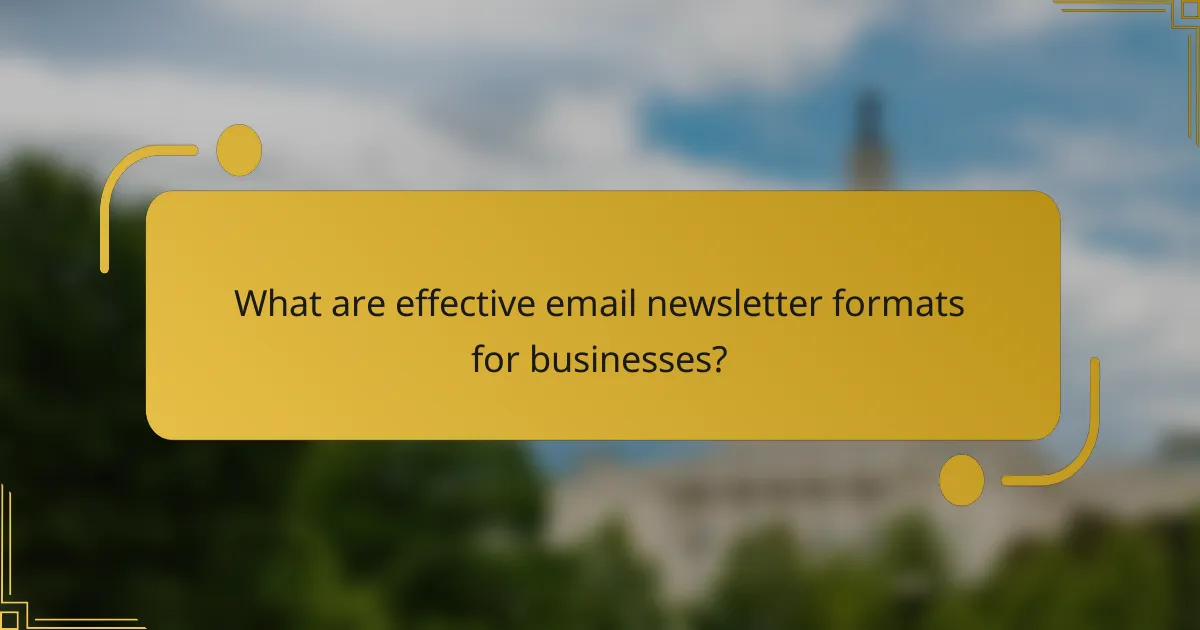
What are effective email newsletter formats for businesses?
Effective email newsletter formats for businesses include curated content, promotional, and informational newsletters. Each format serves distinct purposes and engages subscribers in different ways, making it essential to choose the right one based on your goals and audience preferences.
Curated content newsletters
Curated content newsletters compile relevant articles, blog posts, and resources from various sources, providing value to subscribers without requiring original content creation. This format is ideal for businesses looking to position themselves as thought leaders in their industry.
When creating a curated newsletter, focus on quality over quantity. Select a handful of high-value pieces that resonate with your audience’s interests. Aim for a consistent schedule, whether weekly or monthly, to keep subscribers engaged.
Promotional newsletters
Promotional newsletters are designed to drive sales by showcasing products, services, or special offers. These newsletters often include discounts, limited-time promotions, and product highlights, making them effective for converting subscribers into customers.
To maximize impact, use clear calls-to-action (CTAs) and visually appealing layouts. Consider segmenting your audience to tailor promotions based on their preferences or past purchases. Avoid overwhelming subscribers with too many offers; instead, focus on a few key promotions each time.
Informational newsletters
Informational newsletters provide insights, tips, and updates relevant to your industry or business. This format helps build trust and authority while keeping subscribers informed about trends and best practices.
Incorporate a mix of articles, how-to guides, and company news to maintain interest. Use engaging subject lines to increase open rates and ensure the content is concise and actionable. Regularly solicit feedback to refine your approach and better meet subscriber needs.
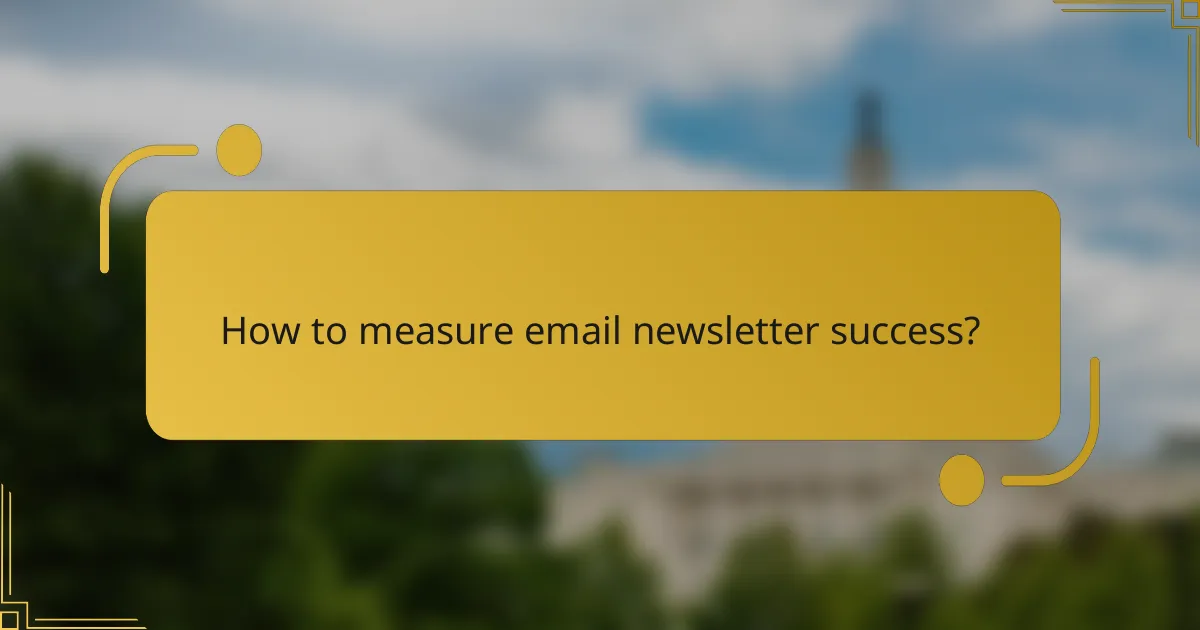
How to measure email newsletter success?
Measuring email newsletter success involves tracking key performance indicators (KPIs) that reflect subscriber engagement and conversion. Focus on metrics such as open rates, click-through rates, and conversion rates to gauge effectiveness and make informed adjustments.
Track open rates
Open rates indicate the percentage of subscribers who open your newsletter. A healthy open rate typically ranges from 15% to 25%, depending on the industry. To improve this metric, consider crafting compelling subject lines and optimizing send times.
Tools like Mailchimp or Constant Contact can help you track open rates easily. Regularly analyze trends over time to identify what resonates with your audience and adjust your approach accordingly.
Analyze click-through rates
Click-through rates (CTR) measure the percentage of subscribers who click on links within your newsletter. A good CTR generally falls between 2% and 5%. To enhance this rate, ensure your content is engaging and includes clear calls to action.
Utilize A/B testing to experiment with different layouts, link placements, and content types. This will help you determine what drives more clicks and refine your content strategy effectively.
Monitor conversion rates
Conversion rates reflect the percentage of subscribers who complete a desired action, such as making a purchase or signing up for an event. A typical conversion rate for email campaigns can range from 1% to 3%. To boost conversions, align your newsletter content with your audience’s interests and needs.
Implement tracking tools like Google Analytics to monitor conversions stemming from your newsletters. Regularly review and optimize your email content and landing pages to enhance the overall user experience and drive better results.
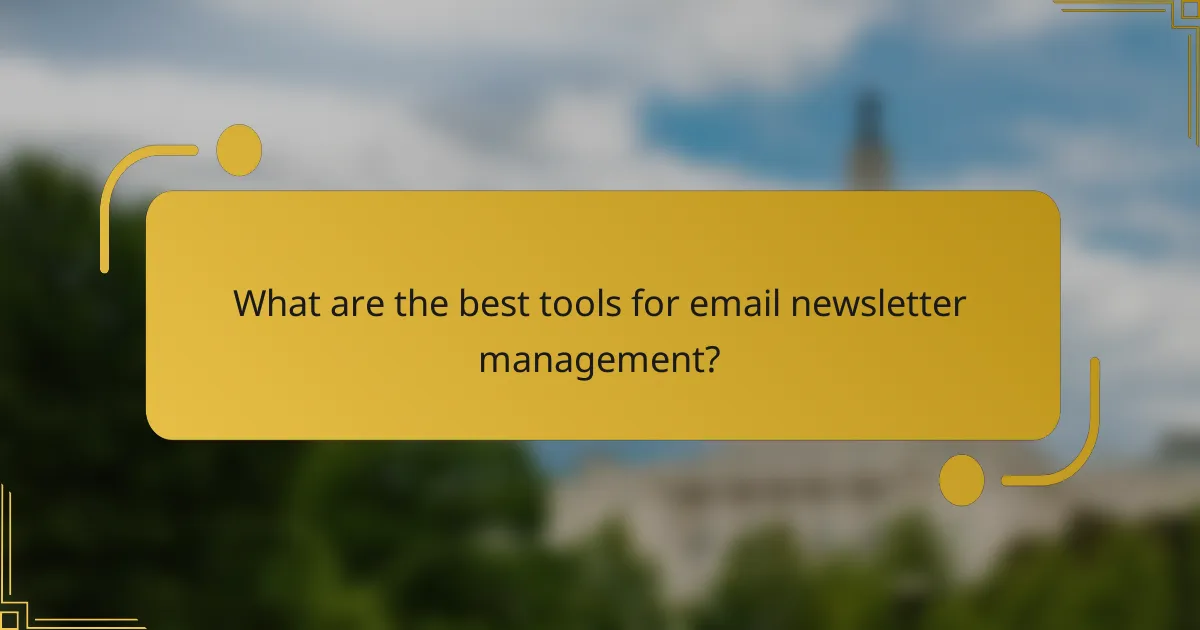
What are the best tools for email newsletter management?
The best tools for email newsletter management streamline the process of creating, sending, and analyzing newsletters. They offer features like automation, templates, and analytics to enhance subscriber engagement and conversion rates.
Mailchimp
Mailchimp is one of the most popular email newsletter management tools, known for its user-friendly interface and robust features. It allows users to create visually appealing newsletters using customizable templates and a drag-and-drop editor.
Key features include audience segmentation, A/B testing, and detailed analytics, which help optimize campaigns. Mailchimp offers a free tier for small lists, making it accessible for startups and small businesses, while paid plans provide advanced functionalities like automation and enhanced reporting.
When using Mailchimp, ensure you regularly clean your email list to maintain high deliverability rates. Avoid common pitfalls like overloading your newsletters with too much content, which can lead to lower engagement. Instead, focus on clear, concise messaging that resonates with your audience.
